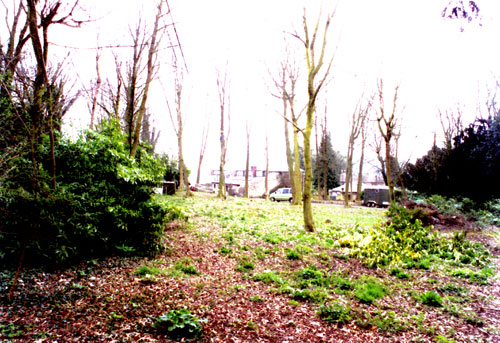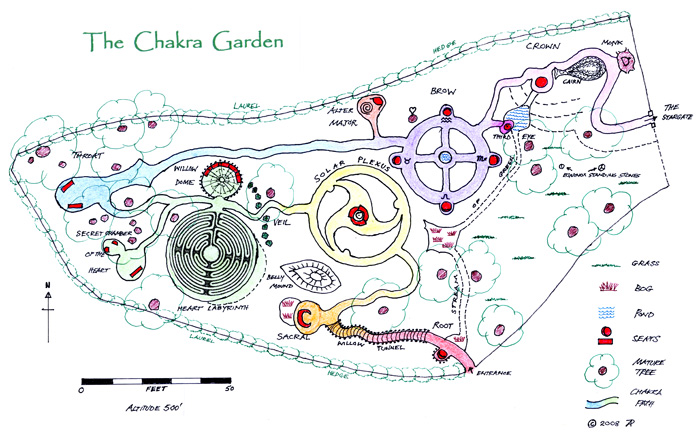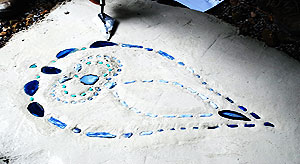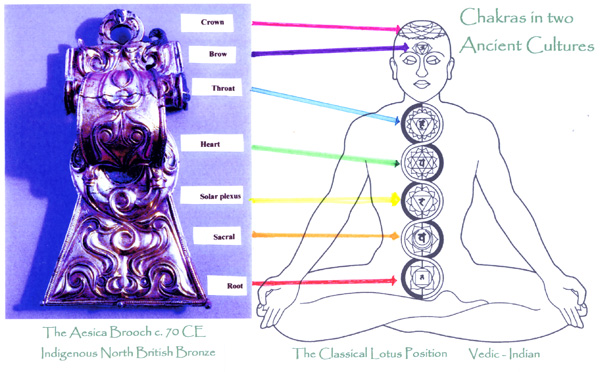| A Walk through the Chakra Garden, 2013
A guided walk through Celia Gunn’s 13-year labour of love, a garden devoted to the chakras, filmed by Gary White. Celia takes us through the garden, describing what we see and giving some of the history of her process of creation, joined by Celia’s husband, author Anthony Thorley and Gary's wife, author Elyn Aviva.
Here are the two parts of the video podcast below: |
[Celia Gunn’s Chakra Garden, Part I] |
[Celia Gunn’s Chakra Garden, Part II] |
This universal principle underpins the Chakra Garden, which was conceived of as an idea by Anthony when we moved here. When we first viewed our home in February 2000, we were impressed to find that it came with a half-acre of self-seeded woodland wilderness. | 
In the Begining - February 2000 | By the time we moved in, four months later, accompanied by several car-loads of plants and bulbs from our last home, the wooded glade had become an impenetrable, shoulder-high green thicket of brambles, nettles, thistles, dock, ivy, red and white campion, ox-eye daisies, grasses, barren strawberry, bindweed, creeping buttercup, burdock, lesser celandine, mallow, plantain, lords and ladies, speedwell, scarlet pimpernel, and Japanese knotweed... Inspired with the idea of a chakric journey garden, Anthony came up with the basic plan in minutes. The actual manifestation has deviated little from that basic plan; the only changes have been as dictated by the energy of the garden itself. | 
Plan of the Chakra Garden
| As an experienced amateur gardener, I was fully aware this would be a long-term project, but it had always been a dream of mine to create a garden from the ground up. This labour of love, the co-creation of a garden that we came to understand is - like most gardens - a temple, a profound spiritual experience for gardener and visitor alike, then proceeded to absorb me as perhaps only one other interaction in my life ever has, to date. There had never been a garden here before; underneath the weeds lay the next challenge: the earth, a heavy clay wrapped round layers of stones and topped with heaps of builders' rubble and years of coal-fire and bonfire leavings. In one area, I came across the buried floor of an ancient building, about six inches below the surface. I can honestly say that I did not dig, but quarried the whole half-acre. So far, I have removed by rough estimate some 50-60 tons of stones, to be recycled for all kinds of use, and added some 30 tons of compost and horse manure. Fortunately, I love every single aspect of gardening: preparing the earth, weeding, planting, pruning.... From the outset, I have tried to work with nature; to accept, respect, protect and enhance habitats for plants, insects, birds and animals. I have come to know the mature trees personally - oak, yew, ash, hornbeam, witch-elm, beech, elder, maple, sycamore and holly - and am gratefully learning the exquisite delights of a woodland garden: the challenging, ever-shifting dappled interplay of shade and light; the trees roaring like wild surf in high winds, gifting an incredible shelter to the frail human working beneath them. Deeply do I appreciate the occasional deer, tiptoeing through newly-planted grass and flashing white-tailed in abrupt departure; grey squirrels racing up trunks and along branches, chittering at being disturbed; the faery-bright flash of wasps speeding through variances of light; the iridescence of dragonflies; the drone of honey-bees, mason bees, digger-bees; the bumble and flit of ladybirds; the pause of hoverflies; the soaring and tumble of dancing butterflies, who favour the Sacral Chakra. The birds bring never-ending pleasure: the darting visit of tree-creeper and wren; the warble of thrush and chink of blackbird; the trill of robin, chirr of finch, twitter of blue-tit; the lonely pipe of buzzard; the hoot and screech of owl; the throat-clearing of crow; the clatter of a departing wood-pigeon; the rusty-clock whirr of an agitated pheasant. In spring, tumultuous bird-song echoes in my head at night as I fall asleep after a day working in the garden. There has been over 3000 years of continuous habitation in the immediate area; the site is mentioned in the Domesday Book. In the fourteenth century, the Carthusians - a silent, non-meat-eating Catholic order of scribes - had a chapel and grange here, and we have revitalised their tradition at the Crown Chakra, as you will see when you take the Tour. Beyond an original rough sketch of the pathway, there was no planned design. Instead, the land spoke, and we learned to hear. Why these patterns? Why go to so much trouble? All the geometry suggested itself; the only rule I gave myself was that, as in nature, there would be no straight lines. In most cases, it was not until after the event that we learned what it was that we were co-creating: a complex system of sacredness utilising features in a garden to ground higher-dimensional forces and assist in the mastering of multi-dimensional consciousness. The seven basic chakras reflect the colours of the rainbow and this is represented in the seasonal hues of shrubs and flowers. At every chakra is a seat, carved from a tree that grew on site. Until recently, the pathway was of woodchips, but this gradually is being replaced by the more permanent, yet green option of limecrete. Possibly the first time a garden path has been made of this material in England, it has the stunning appearance of a Pathway of Light. | Embarking on the chakric journey at the Root Chakra, where the colour red is present in some plant or other all year round, a small bog garden reminds us that water is the root-source of all life. A living willow tunnel, dedicated as the birth-canal, leads to the Sacral Chakra, where the seat has been skilfully carved into the shape of the Vedic symbol. Orange flowers and stems enhance the energy. Close by is the Mound, which represents the pregnant belly of the Mother. The design of the triskele at the Solar Plexus - a sun-wheel, turning deosil - is the exact replica of one engraved onto an Iron Age stone spindle-whorl, found in an archaeological dig at the head of our driveway and now in the Taunton Museum. The seat inside the wheel has been carved to turn widdershins. Yellow is the main colour, but some orange and red have been incorporated to represent the 'fire in the belly' of this dynamic chakra. At the Heart Chakra lies an eleven-fold Labyrinth, a model of the Miz-Maze in Wiltshire and also Chartres Cathedral in France, which Anthony was guided in a dream to lay as a mandala. The visitor may sit and meditate upon a heart-question in the Willow Dome, then contemplatively walk the Labyrinth, and perhaps proceed to the Secret Chamber of the Heart to await an answer. The colour green is predominant here; pink has been included to represent Love. Chimes perpetually enliven the Throat Chakra, which has the feeling of the nave of a church and opens out like a sounding instrument. Periwinkle provides almost year-round sky-blue, and each spring, this chakra becomes a surreal, underwater type of mesmeric experience, with the blooming of the many bluebells I found throughout the site having been gathered and replanted here. A crystal representation of the symbol from the Throat Chakra of the Aesica Brooch has been laid into the path here. . Hidden away, the Alta Major Chakra seat is a masterpiece, carved from the crown of the tree and symbolising the vision of the future combined with the wisdom, guidance and far-memory of the past. This lesser-known but powerhouse of a chakra is off the rainbow-spectrum, and marked by bronze and earth-coloured plants. The Brow Chakra, a small physic garden planted with medicinal herbs, some of which flower indigo, has been laid out as an equal-armed Celtic circled cross, representing the qualities of balance, harmony and healing. The seats are aligned to the four directions and are carved with the four fixed signs of the zodiac, which are also symbolic of the four Gospels. The water of a wildlife pond represents reflective and far-seeing qualities of the Third Eye Chakra. The ground then naturally rises to the heights of the Crown Chakra, from where it is possible among blooms of violet and purple, white and gold, to look back over the whole journey and then turn to contemplate a large and unique stone structure, which evolved organically into the shape of the Holder of Earth Law and Earth Records: the Whale. From here, the entire system is subtly linked back to the Root Chakra, so that the energies are in continual circulation. At the extreme head of the Crown Chakra, stands the Great Guide and Overseer of the chakric journey. Finally, where is there to go after such a journey, other than to leave through a Stargate? | After a few years, we came to understand that our long, shared driveway, lined with lime trees, is the necessary avenue to a subtle temple: a channel for higher consciousness states. With a large group of like-minded friends, this avenue was ritually dedicated in 2006. Based on seasonal and cosmic time-cycles, spontaneous ceremonial activities take place in the Chakra Garden throughout the year, weaving together the mundane and spiritual realms. This form of life is most conducive to human happiness and freedom, to peaceful and settled community, and to balance the lack of stability in modern life and maintain people in harmony with nature. With the assistance and persistence of nature, a one-woman working team has brought one man's wide-reaching vision into manifestation. Many are the tales I could tell, as each chakra has expressed its own voice from the outset, almost as if the Chakra Garden were already lying here in wait. Weaving together the mundane and the sacred, it is a system to maintain stability and harmony by what John Michell has termed the principle of enchantment. Experiencing the Chakra Garden makes it possible for people to find enchantment by making the garden into a cosmology, a model of the universe, which can help the development of a sharper and more intuitive perception. Our hope is that by taking the Tour, you too may experience the beauty, peace and healing power of the Chakra Garden. | 
The Main Chakras and the Aesica Brooch | The Sanskrit word chakra means 'spinning wheel', and refers to the energy or consciousness centres arrayed in an interdependent sequence along the human spine from base to head, Root to Crown, sequenced in the order of the colours of the rainbow. Embodying the primary dimensions of reality within matter and spirit, chakric energy systems are also found in churches and the landscape. Sometimes they are in a straight line; sometimes curved and sinuous. Commonly described as seven major chakras, there is actually an undetermined number of major and minor ones. The Chakra Garden called for ten chakras. There is only one way in, through the Root Chakra, and one way out, through the Stargate beyond the Crown Chakra. A visitor walks through the chakras on a journey of renewal and reflection, during which their own chakras often resonate with the chakras in the garden. There is a giving and receiving healing energy, so the visitor will perhaps stop and sit to meditate on a specific personal issue in one or more chakras on one of the specially carved seats. We appreciate that as much as is taken from the experience, is given back to the garden itself. Celia Gunn & Anthony Thorley
Spring 2008 | |


